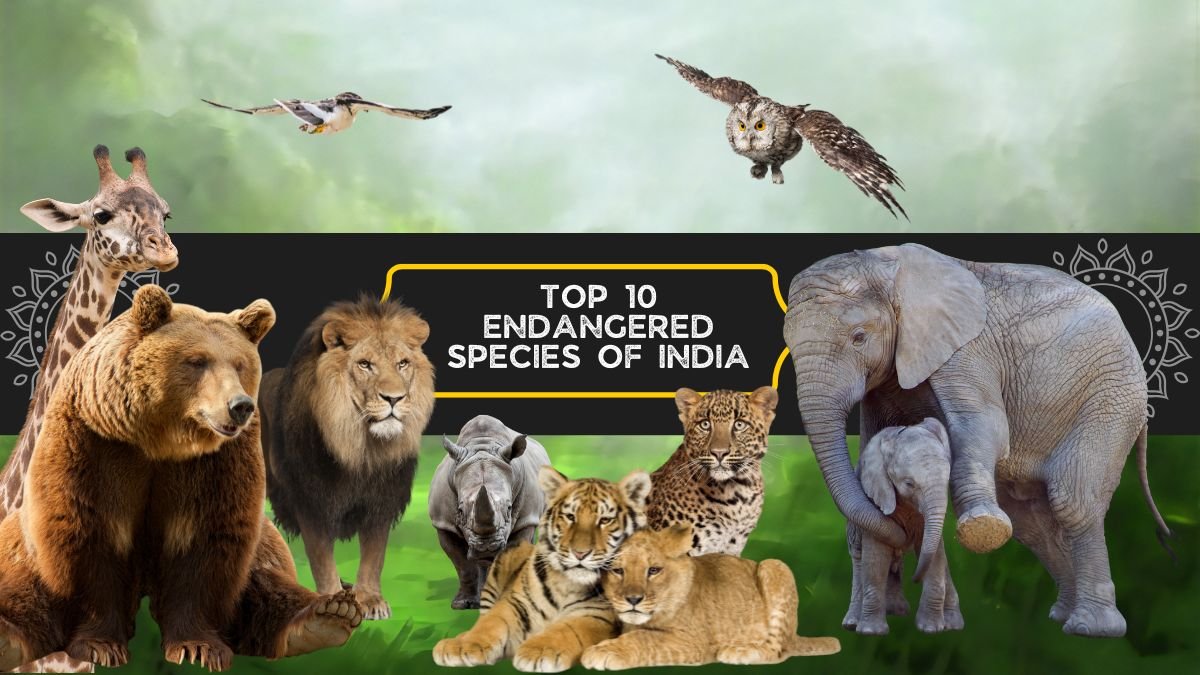Introduction
India is a precious treasure of biodiversity, but its natural heritage of thousands of years is facing many problems today. Forests are being cut down, markets are being captured, and many species are in danger. Many rare species of animals and birds are on the verge of extinction. In this article, we will mention 10 of such critically endangered species, which are on the brink of life. Perchance we might learn a thing or two about some of the conservation measures in place.
10. Red Panda (Ailurus fulgens)
Lifestyle
Red pandas are found in the eastern part of the Himalayas—Sikkim, Arunachal, Meghalaya and West Bengal. They have a thin red-brown body and a very thick tail. It is a tree-dwelling animal and bamboo is the main part of its diet. Apart from this, it also eats fruits, insects.
Threats
- Deforestation
- Spread of agriculture and human areas
- Illegal hunting and use of their skins in handicrafts
Efforts
Protected areas have been established by the government and non-government organizations. Anti-poaching teams patrol regularly and space is being created for their habitat by planting bamboo in the forest. Campaigns are also being run to make local people aware.
9. Lion-tailed macaque (Macaca silenus)
Lifestyle
This rare monkey of the Western Ghats lives in dense rain forests. Black fur and silver-colored ‘mane’ around the head make it unique.
Threats
- Reduction of forest areas
- Deforestation due to agriculture
- Accidents on forest transport routes
Efforts
Large areas have been made protected zones by the Wildlife Sub-Department. Wildlife corridors are being built so that they can safely travel from one forest to another. Local communities are being explained the benefits of forest conservation.
8. Nilgiri Thar (Nilgiritragus hylocrius)
Lifestyle
This mountain goat lives in the high grasslands and rocky slopes of the Western Ghats. The males have strongly shaped curved horns, which make them recognizable.
Threats
- Lack of pastures
- Lack of grazing land
- Illegal poaching
Efforts
High altitude areas like Eravikulam and Silent Valley in Kerala, Tamil Nadu and Karnataka have been converted into protected zones. Tourism income generating models have been adopted so that rural communities can get involved with conservation.
7. Snow Leopard (Panthera uncia)
Lifestyle
This is a beautiful tiger-like animal found in the heights of the Himalayas, whose white and blue stripes and long tail make it special.
Threats
- Changing climate and melting of glaciers
- The human conflict that arises when these animals cross the cosmic boundaries during their seasonal migration tour
- Illegal hunting
Efforts
Many protected zones have been created in the Himalayan ecological region—anti-poaching patrols are regular here. The local population is being made aware. GPS camera tagging has expanded the scope of their study.
6. Indian Rhinoceros (Rhinoceros unicornis)
Lifestyle
This strong rhinoceros found in the riverbanks and grasslands of Assam and Bengal is known for its one horn and thick armor-like skin.
Threats
- Poaching (horns)
- Destruction of homes due to flooding and drainage
Efforts
Along with conservation in Kaziranga, Manas, strengthening of Sono Sima river system which provides water and food sources. Tourism increased through Rohidom, Mimans, guided tours so that local people can benefit.
5. Bengal Tiger (Panthera tigris tigris)
Lifestyle
Victorious and mighty, its name itself reflects its uniqueness. It is also the national animal of India.
Threats
- Deforestation
- Agriculture, urban sprawl
- Poaching
Efforts
‘Project Tiger’ is a major initiative in which tiger reserves in Uttarakhand, Maharashtra, Madhya Pradesh and Karnataka were expanded. Human tiger conflict-authority system, monitoring, corridors and strict action by the government have increased their population.
4. Indian Pangolin (Manis crassicaudata)
Lifestyle
This reptile comes out at night and eats ants and termites. It has scales on its body, which are its specialty.
Threats
- Illegal hunting for scales
- Deforestation
Efforts
The efforts of CITES and the government have reduced illegal trade. Campaigns are on to conserve forests, stop scale use, provide employment to people who leave the forest.
3. Asiatic Lion (Panthera leo persica)
Lifestyle
Found in the Gir range of Gujarat, this Indian lion is a different sub-species from the African, with less mane and slightly smaller in size.
Threats
- Low population
- Population dispersal and conflict
Efforts
‘Gir Landscape’ declared a protected area. Preventing terror control, resolving conflicts with tailed monkeys, translocation zones were created. In 2023, their number increased to about 700.
2. Gharial (Gavialis gangeticus)
Lifestyle
The historic crocodile found in the Ganga-Yamuna and Vindhya rivers, is important for long nose and community structure.
Threats
- Habitats affected due to dams, river changes
- Pollution and fishing pressure
Efforts
River protected areas of Chambal range, family arrays were created. Captive-breeding was done, river clean-up campaigns, and water inspection increased with the police.
1. Great Indian Bustard (Ardeotis nigriceps)
Lifestyle
This huge bird is seen flying in the winds, found in desert and semi-arid areas like Rajasthan, Gujarat and Andhra Pradesh.
Dangers
- Industrialization, power lines
- Expansion of agriculture
- Expressway construction, collision with line
Effort
Identifying and undergrounding power lines; grassland protection, captive-breeding, educational campaigns.
Conclusion: We can build a safe and prosperous future
As we have seen, these 10 endangered species of India are the voices that speak to the silence of the environment. If we want to protect our heritage, we have to adopt conservation measures for them too—this is possible only through forest conservation, involving local communities and effective policy governance.
With each one of us joining hands, the government, NGOs, village communities and research institutions can ensure that these sensitive lives are not just preserved but also become a symbol of living for a long time.















